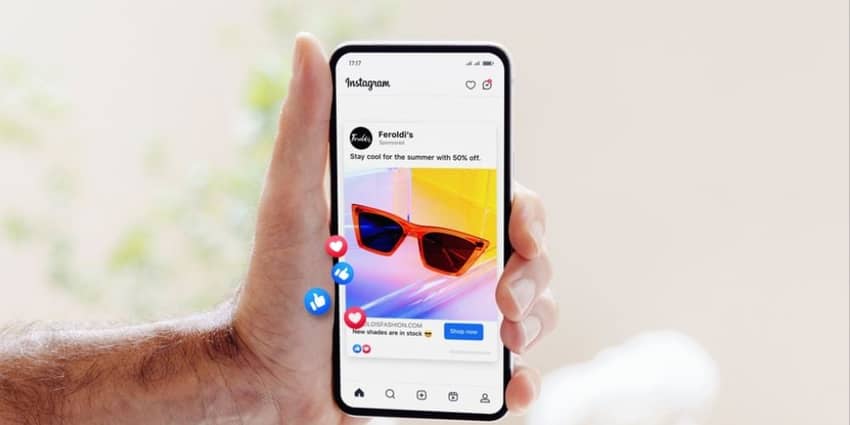If Facebook isn’t a part of your ecommerce marketing plan, you should correct that.
According to Genroe, Facebook is Australia’s most popular social network among 16 to 64-year-olds. Over 16 million people log into the platform every month, and it’s the third highest-trafficked website after Google and YouTube.
To top it off, approximately 1.212 billion consumers are projected to make monthly purchases on Facebook Marketplace. Thats alot of potential customers!
But how do you make your ecommerce business stand out on a social media platform this big?
Great copywriting is the answer.
You don’t need to be a word nerd or literary expert. You just need to know how to connect with your audience.
In this article, we’ll break down every component of writing effective Facebook ad copy so you can connect with your audience and maximise conversion rates.
You’ll also learn how to leverage AI to help with your direct response copywriting and build a strategy to generate the desired results for your ecommerce business.
Let’s begin.
What is Facebook Ad Copy
There are five components to a Facebook Ad. They are:
- The Primary Text: This appears right underneath your account name. Only the first 125 characters show here, including spaces, so you need to make every letter count.
- The Creative: This is generally an image, carousel or video. The creative will have a significant impact in attracting your target audience and contributing to Facebook's algorithm.
- The Headline: This is right underneath the creative and is usually around 40 characters or less. It should emphasise what the potential customer gets.
- The Description: This comes after the headline and is usually 30 characters or less. The copy should be different. Otherwise, it’s a wasted opportunity to convince potential customers to click on your ad.
- The Call to Action: Finally, you have a CTA, which is a button you can choose from a dropdown menu. Some of the options are download, learn more or shop.
Mastering the copy for each component will build an effective Facebook ad. They should all complement one another to convince the potential customer why they should engage with your ecommerce business.
Consider each part to be like a piece of digital real estate. Try to add unique and impactful copy in each section so you're not repeating the same thing and wasting valuable digital real estate.
How Copywriting Influences the Facebook Algorithm
Another good reason to master copywriting is that it directly influences the Facebook algorithm. While it continues to learn and evolve as more people interact with their feeds, some components never change:
- Facebook prioritises content to users that is meaningful, relevant and informative. By understanding your audience’s interests and behaviours, you can create copy that speaks to their wants and needs.
- Another Facebook finding is that their users value accurate and authentic content. The algorithm will reduce the ranking of misleading, sensational or spammy posts. In other words, be honest and don’t exaggerate your offering through your copy.
- The algorithm is smart enough to know when people are trying to manipulate it. That could be using clickbait headlines or sending people to a deceptive landing page. If your copy convinces people to hit the report or block button instead of the CTA, then Facebook will step in to put an end to the ad.
Tips for Writing Compelling Facebook Ad Copy
Crafting Facebook Ad copy can excite, entertain and persuade your potential customer to take action. But it needs to connect and make the choice to engage seem natural. The trick is to make sure every line of copy is essential and to remove all fluff and unnecessary text. Here’s some tips to keep in mind:
- Write to One Person: Don’t try to cater to everyone. It’s one of the biggest mistakes in marketing. Instead, focus on one person in your target audience. Give them a name and backstory. Understand their emotions and pain points. Convince this person why buying your product would solve their problems.
- Master the Hook: A hook is a short, attention-grabbing statement that holds the reader's attention. Creating a compelling one will stop thumbs in their tracks and keep potential customers engaged. Try using curiosity, a big promise, or a central benefit in your hook to grab their attention.
- Focus on Benefits Instead of Features: It’s tempting to list all the features of your products, but customers are more interested in how they will benefit them. For example, don’t just mention your sunglasses offer UV protection. Instead, describe how they keep the glare out of their eyes so they're not dazed by the sun. People care about what's in it for them and how it will affect them on a personal level.
- Use Social Proof: Incorporate testimonials from your current customers to demonstrate how your products have improved their lives. Choose reviews that speak to your target audience. User-generated content videos can be a great way to convey this to your customers.
- Tell Stories: Using storytelling techniques can ignite an emotional response from your target audience. You can describe a day in the life of your customers before they purchased your product and compare it to what it looks like after they bought it.
- Use White Space: Longform copywriting is an option for Facebook Ads, but you’ll have to test whether it delivers your desired results. If it does, ensure that you break up the copy. One long block of text will put people off. The best practice is for each paragraph to be two to three sentences max.
- Make It Easy to Read: In addition to making long-form copy presentable, it needs to be readable. Before publishing your Facebook Ad, test it through apps like the Hemingway App. It will highlight sentences to improve and grade your copy based on how easy it is to read. Aim between Grades 5 and 7 for the best results.
- Ensure All Elements Work Together: Your text, images, and call to action should all complement one another. Think of it like an orchestra. All the instruments need to work together to create beautiful music.
Effective Copywriting Frameworks
While copywriting is a creative endeavour, some frameworks can help you master the art. Here are some of the most effective for ecommerce businesses.
| Copywriting Framework | How It Works |
|---|---|
| Story-Outcome-Benefit | Share a story about a customer who used your product. Highlight the outcomes the customer received. Present how the reader can benefit as well. |
| Problem-Agitate-Solution | Highlight a problem your target customer has. Intensify the issue. Provide your product as the solution. |
| Before-After-Bridge | Present a world before your customer discovers your product. Show what it could be like after. Bridge the gap with your product. |
| Question-Provoke-CTA | Open with a question that addresses your customer’s pain point or need. Use curiosity to provoke interest. End with a strong call to action. |
| Claim-Proof-Benefit | Make a claim that resonates with your audience. Provide proof to back up the claim. Explain how it benefits your audience. |
| Context-Challenge-Solution | Set the context. Introduce a challenge your customers face. Provide the solution. |
How to Use AI to Help You Write Facebook Ad Copy
If you’re a team of one, crafting the perfect Facebook Ad copy can take time away from other vital tasks. With the introduction of generative AI, like ChatGPT, business owners can automate the first drafts of their copy or use it as inspiration to find the words they need.
However, AI isn’t perfect. Here are some tips to remember if you choose to use it to write your copy:
- Make sure the copy sounds like a human wrote it. People are getting wiser about what a person creates and what has been generated by AI.
- Always refine the content to your voice and personality. AI copy is often bland and only scratches the surface.
- If there are any claims in the copy, make sure to fact-check them.
- ChatGPT produces content in US English. Paste the copy into your word processor and ensure it’s set to Australian English. Alternatively, use Grammarly to highlight the words that need to be changed.
Choosing an AI Prompt
The more detail you provide ChatGPT, the better your results will be. You’ll want to provide information such as your ideal customer persona, the product you wish to promote, and the desired actions. For even better results remember to provide ChatGPT context about your business, branding, and the style of writing you're looking for.
“I want you to write a persuasive Facebook ad copy that resonates with people interested in [product name]. Here’s more information about my business for context. [Name of business] is a [description of business] that specialises in [type of products].
Here is everything you need to know about my ecommerce business.
- [Short history of your business]
- [Mission statement]
- [Business values]
- [Target demographic]
- [The problems your business solves]
- [Unique selling proposition.]”
After this, you can go into more detail about the specific type of copy you need. Maybe you need to change the tone, or perhaps you need it to remove unnecessary information. Simply write what changes you need into ChatGPT in the same way you would to a person you're speaking to.
You can also use these ChatGPT prompts and the copywriting frameworks referenced above to make the copy more compelling.
- Driving Traffic: “Write Facebook ad copy that will use the influence and reach of my [ecommerce business] to drive traffic and sales for my [product] for my [target customer]. Use the [copywriting framework] to connect with the reader.”
- Demonstrate Credibility: “Write Facebook ad copy that will demonstrate the expertise of my [ecommerce business] to educate my [target customer] on the benefits of my [product] and persuade them to make a purchase. Use the [copywriting framework] to highlight my authority.”
- Promote Authenticity: “Write Facebook ad copy that showcases the authenticity of my [ecommerce business] to engage my [target customer] and persuade them to take [desired action] on my [product]. Use the [copywriting framework] to demonstrate relatability.”
- Social Proof: “Write Facebook ad copy that highlights the social proof and credibility of my [ecommerce business] to persuade my [target customer] to try my [product] and share their positive experience with their followers. Use the [copywriting framework] to engage readers.”
- Create Urgency: “Write Facebook ad copy that will create a sense of urgency for my [target customer] by featuring offers and promotions for my [product]. Use the [copywriting framework] to encourage action.”
How to Create a Facebook Ad Strategy
Establish Goals
The best place to start is determining what results you hope to see from your Facebook Ads. You might want to raise brand awareness or increase engagement with your audience. Most commonly though, you’ll be running either a conversion campaign to get sales.
Define Your Audience
Speaking of the right people, it’s vital that you define your target audience before continuing. Facebook lets you get down to the finest detail on who you want to show your ad to. Some of the options available to you are:
- Location: In addition to country, you can narrow it down to states and even cities. It’s perfect if you have a strong regional following compared to metro cities.
- Gender: You can choose to target men, women, or everyone.
- Interests: This is where you can really get specific. If you sell activewear, you should target people interested in fitness, yoga, running, or other athletic activities.
- Behaviours: You can use this option to show your ad to people who have visited your website or purchased from your store.
- Connections: This option is if you want your ad to appear for people who already like your Facebook page or are connected to your business in other ways.
- Custom: You can also target existing customers who have purchased products via ads in the past.
Use the 3-2-2 Method to Test Content
If you’re unsure what content will impact your target customer best, you should test a few different Facebook Ad styles. The 3-2-2 method is just one example. What you’ll do is create three different versions of ad copy, two different versions of the primary text, and two different headlines. Here’s how you can set that up on Facebook:
- When you get to the page to create a new ad, select the option for Dynamic Creative.
- Enter your creative ad copy, descriptions, headlines, and call to action.
- Facebook will then test all the combinations to see which ones generate the best response.
This approach will save a lot of time as you won’t have to create multiple variations of the same ad.
Track and Analyse Results
Finally, you will want to spend some time analysing the results. Reviewing the data will inform what Facebook Ads you create moving forward.
There’s a lot of different metrics that can inform you on different aspects of the campaign, but the 3 most important are:
- Click-Through Rates: Your click-through rate will reflect how well your ad resonates with your Facebook audience. It’s the people who click your link after seeing your ad. You’ll want to aim for somewhere between 2% and 5%. But this number can vary based on your industry. Usually, the higher your click-through rate, the better your cost per click will be.
- Cost Per Click: Cost Per Click (CPC) on Facebook ads is a digital advertising metric that represents the amount you pay each time someone clicks on your ad on Facebook. Usually, the higher the cost per click, the less your audience is relating to your ad. Facebook will charge you more money if they believe your ad is ruining people's experience on the Facebook platform. If you see a high cost per click, it’s a reflection that your ad creative is likely underperforming, and therefore it would be better to try different ad creatives until you can get around 1-2 dollars per click.
- Cost Per Conversion: This metric will determine if you want to continue producing Facebook Ads. Calculating the cost per conversion is as easy as dividing the total amount you spend on the campaign by the total number of conversions. You could even assess the average revenue per user if you think this is a more relevant metric.
Keep in mind that at the beginning of these campaigns, your metrics may start off bad because Facebook doesn't have enough data to find you the right audience. Try to wait until a couple of conversions before you assess whether the ad is successful or not. However, if your CPC is starting off at somewhere like 8-10 dollars, which is unusual for your industry, it might be better to experiment with different ad creatives and copy.
The most critical reference point is your return on ad spend. If this meets your expectations, you should continue to refine and test new copy to build on its success.
Mastering Facebook Ad Copy
Finding the right words for your Facebook Ad copy takes a lot of trial and error. You need to clearly define your audience and understand what resonates with them. Testing various combinations of the same ad can help, as will using AI for inspiration.
But the most crucial activity is reviewing your data. It will tell you what’s working, what’s not, and where you should adjust your strategy. Establish goals and regularly check your return on ad spend to ensure your investment is paying off.








.png)

 Facebook
Facebook Twitter
Twitter Instagram
Instagram Linked In
Linked In YouTube
YouTube